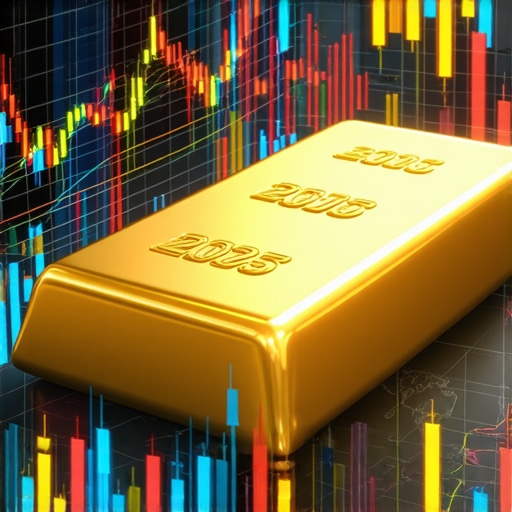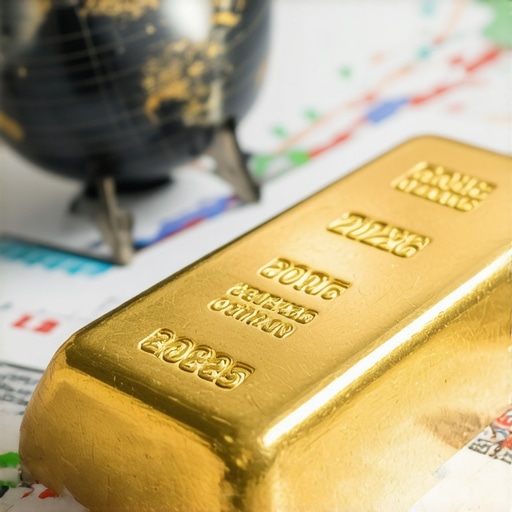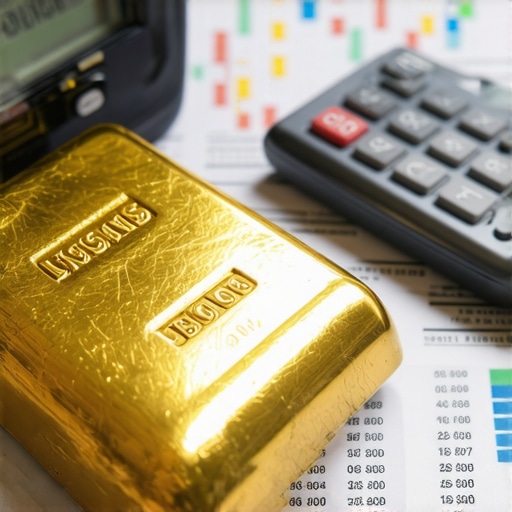Unveiling the Complex Web of Gold Demand: A Deep Dive into 2025 Market Dynamics
In the realm of precious metals, gold remains a cornerstone of global wealth preservation and economic resilience. As we approach 2025, understanding the multifaceted demand factors that influence gold prices is crucial for investors and policymakers alike. This exploration synthesizes expert insights, market analysis, and emerging trends to decode the intricate web shaping gold’s trajectory.
Global Economic Uncertainty and Its Amplified Role in Gold Demand
One of the most significant demand drivers in 2025 is the persistent geopolitical and economic uncertainty. Factors such as fluctuating interest rates, inflationary pressures, and geopolitical tensions escalate the appeal of gold as a safe-haven asset. According to a recent market analysis, the increased demand from institutional investors and central banks underscores gold’s strategic importance in safeguarding wealth during turbulent times.
Technological and Industrial Demand: An Emerging Frontier
Beyond traditional investment channels, technological advancements and industrial applications are shaping gold’s demand landscape. Gold’s unique properties make it indispensable in electronics, aerospace, and medical devices. As innovations proliferate, especially in renewable energy sectors and quantum computing, the industrial demand for gold is expected to gain momentum, subtly influencing market prices.
Jewelry and Cultural Consumption: The Persistent Cultural Anchor
Jewelry remains a primary consumption sector, driven by cultural traditions in emerging markets and shifting consumer preferences. The demand in regions like India and China continues to support gold prices, with trends indicating a resilient appetite for both investment-grade and decorative gold. However, fluctuations in discretionary spending and technological alternatives may modulate future demand levels.
How Do Supply Chain Constraints and Mining Output Impact Price Volatility?
Supply dynamics, especially mining output and geopolitical disruptions in major gold-producing countries such as South Africa and Russia, significantly influence market stability. A comprehensive supply-demand analysis reveals that constrained output coupled with rising demand could lead to increased volatility and upward pressure on prices.
What Role Will Central Bank Policies Play in Shaping Gold Prices in 2025?
Central banks’ gold reserve management and monetary policies are pivotal in setting the tone for future prices. With many nations reassessing their gold holdings amidst inflation concerns and currency fluctuations, their strategic purchases or sales could catalyze market shifts. Detailed insights into central bank activity can be explored here.
To navigate this complex landscape, investors should consider diversifying their portfolios with a mix of physical gold, ETFs, and mining stocks, aligning with emerging demand trends and supply constraints. For a comprehensive strategy, consult our expert guide to diversified gold portfolios.
As the market evolves, staying informed about global economic trends and demand cycles is essential. Engage with our community of experts and contribute your insights to shape a resilient investment approach in 2025 and beyond.
Deciphering Gold Demand Cycles in 2025: Strategic Insights for Investors
Understanding the nuanced phases of gold demand cycles is essential for investors aiming to optimize their portfolios in 2025. These cycles, driven by macroeconomic shifts, geopolitical events, and technological innovations, can significantly influence gold prices. Analyzing historical patterns in conjunction with current market signals enables investors to anticipate potential turning points and capitalize on emerging opportunities.
What Are the Key Indicators Signaling Demand Reversals?
Several leading indicators can hint at impending shifts in gold demand. For instance, changes in central bank reserve policies, fluctuations in jewelry consumption, and variations in industrial applications serve as crucial signals. Monitoring these demand drivers helps in crafting timing strategies for entry and exit points, especially when combined with technical analysis of price momentum and volume patterns.
Can Market Sentiment and External Shocks Accelerate Demand Cycles?
Market sentiment, often swayed by geopolitical tensions or economic crises, can accelerate demand surges or trigger rapid declines. External shocks such as currency devaluations or trade disruptions tend to amplify these effects. Recognizing the signs of shifting investor confidence requires a blend of qualitative insights and quantitative data analysis. Tools like sentiment indices and geopolitical risk assessments are invaluable in this context.
How Can Advanced Data Analytics Enhance Demand Cycle Predictions?
Leveraging big data and machine learning models allows for more precise forecasting of demand cycles. By analyzing vast datasets—from macroeconomic indicators to social media sentiment—investors can identify subtle patterns that precede demand shifts. Such technological integration elevates traditional analysis, offering a competitive edge in the dynamic gold market. For a deeper dive into predictive analytics, consider exploring advanced market analysis techniques.
Engaging with these sophisticated tools and maintaining a flexible investment stance enables stakeholders to navigate the complexities of demand cycles effectively. Sharing insights or asking questions in our community forum can also sharpen your market acumen, ensuring your strategy remains resilient amid volatility.
Unraveling the Influence of Geopolitical Shocks on Gold Demand Dynamics
In an increasingly interconnected world, geopolitical events wield significant influence over gold demand, often triggering rapid market adjustments. Conflicts, diplomatic tensions, and policy shifts can cause sudden spikes in demand as investors seek refuge from currency devaluations or economic instability. For instance, the escalation of conflicts in key regions frequently leads to a surge in central bank gold purchases, as nations aim to diversify reserves amidst uncertainty. According to a detailed report by the World Gold Council, geopolitical shocks have historically precipitated demand surges that can outpace supply responses, thereby amplifying price volatility.
The Role of Technological Innovation in Shaping Future Gold Consumption
As technological frontiers expand, gold’s role in emerging industries becomes more pronounced. Quantum computing, for example, relies heavily on gold nanostructures due to their exceptional electrical conductivity and stability. Similarly, renewable energy technologies, such as solar panels and advanced electrical contacts, are increasing industrial consumption. This technological integration not only sustains demand but also introduces new pricing sensitivities linked to innovation cycles. Investors should monitor patents, R&D investments, and industry adoption rates, which serve as early indicators of shifts in industrial demand. The integration of big data analytics can further refine forecasts by correlating technological trends with macroeconomic variables, giving market participants a predictive edge.
How Do Monetary Policies and Gold Reserve Management Interact in 2025?
Central banks’ monetary strategies, especially those involving gold reserves, are vital levers influencing market direction. As nations reassess their reserve portfolios amidst inflationary pressures, their decisions to accumulate or divest gold can send strong signals. For example, increased central bank purchases often precede bullish price movements, whereas sales might indicate a strategic shift or liquidity needs. The International Monetary Fund (IMF) and individual central banks’ disclosures, combined with advanced data analytics, enable investors to anticipate these moves well in advance. Analyzing patterns such as reserve composition changes, transaction volumes, and policy statements provides nuanced insights into future demand cycles.
What Are the Challenges in Differentiating Between Short-term Fluctuations and Structural Demand Shifts?
Distinguishing transient market noise from genuine structural demand changes requires sophisticated analytical tools. Short-term volatility can be driven by speculative trading, macroeconomic releases, or sudden geopolitical news, often causing misleading signals. Conversely, sustained shifts typically manifest through consistent policy actions, technological adoption rates, or demographic trends. Employing machine learning models that incorporate multi-source data—such as supply chain metrics, investor sentiment indices, and macroeconomic indicators—can help decipher these complex patterns. Recognizing the difference is crucial for strategic positioning, ensuring that investors do not react prematurely to ephemeral market movements.
For those committed to mastering these intricacies, engaging with cutting-edge analytics platforms and participating in expert forums can sharpen decision-making. Staying ahead in the gold market’s evolving landscape involves continuous learning and adaptation, leveraging both technological advancements and deep market understanding.
Navigating the Digital Revolution: Gold’s Role in Tech-Driven Economies
As technological innovation accelerates, gold’s industrial applications are poised to expand beyond traditional sectors. The integration of gold in emerging fields such as nanotechnology, quantum computing, and renewable energy introduces a new layer of demand that is both complex and highly sensitive to technological breakthroughs. Investors must monitor patent filings, industry R&D investments, and technological adoption rates to anticipate shifts in industrial demand. This nuanced understanding can inform strategic asset allocation, especially as these sectors often operate on long-term innovation cycles. For instance, recent advancements in quantum computing hardware rely heavily on gold nanostructures, underscoring gold’s critical role in next-generation technologies.
Central Bank Gold Policies: The Hidden Currents Steering Market Dynamics
Central banks’ strategic decisions regarding gold reserves remain a pivotal, yet often underappreciated, influence on global prices. In 2025, the trend of reserve diversification continues, with many nations increasing their gold holdings as a hedge against currency volatility and geopolitical instability. Analyzing central bank disclosures, transaction volumes, and reserve composition changes can reveal emerging patterns that precede price movements. Advanced data analytics, coupled with geopolitical risk assessments, enable investors to decode these reserve management strategies and position themselves advantageously. For example, the gradual accumulation of gold reserves by emerging economies signals a potential shift in demand fundamentals.
Expert-Driven Analytical Techniques: Unlocking Market Cycles with Precision
Utilizing machine learning and big data analytics offers a transformative approach to understanding and predicting demand cycles. By integrating macroeconomic indicators, supply chain data, investor sentiment, and social media analytics, these sophisticated tools help distinguish between short-term volatility and genuine structural shifts. For instance, pattern recognition algorithms can identify early signs of demand reversal, allowing investors to adjust their portfolios proactively. As market complexity grows, embracing these advanced techniques becomes essential for maintaining an edge. To deepen your analytical capabilities, explore resources such as the latest market analysis tools.
Anticipating Geopolitical Shocks: The Hidden Catalyst for Demand Surges
Geopolitical tensions continue to serve as potent catalysts for demand surges in gold. Conflicts, diplomatic crises, and policy conflicts often lead to abrupt shifts in investor sentiment, prompting central banks and institutions to increase their gold holdings rapidly. The World Gold Council highlights that such shocks have historically outpaced supply responses, causing heightened volatility. Monitoring geopolitical developments through risk indices and real-time news analytics is crucial for timely decision-making, especially in a landscape where unpredictability is the norm.
Strategic Investment Approaches for the Evolving Gold Market
In an environment characterized by rapid technological change and geopolitical uncertainty, investors should consider diversified strategies, including physical gold, ETFs, and mining equities. Emphasizing a data-driven approach, complemented by insights from market experts, can help optimize exposure and mitigate risks. Developing a dynamic portfolio aligned with emerging demand signals and supply constraints is essential for capitalizing on future growth opportunities. For tailored guidance, consult our comprehensive portfolio strategy guide.
Expert Insights & Advanced Considerations
1. Strategic Diversification Is Key
Leveraging a mix of physical gold, ETFs, and mining stocks allows investors to hedge against volatility driven by supply constraints and demand fluctuations, ensuring resilience in turbulent markets.
2. Monitoring Central Bank Activities Offers Early Signals
Central bank reserve adjustments, especially in emerging economies, serve as critical indicators of future demand trends. Staying informed on these moves provides a strategic edge in timing market entries and exits.
3. Embracing Advanced Data Analytics Enhances Prediction Accuracy
Utilizing machine learning models and big data analytics can uncover subtle patterns preempting demand shifts, transforming traditional analysis into proactive decision-making tools.
4. Geopolitical Risk Assessment Is Crucial
Geopolitical tensions often trigger demand surges; real-time risk monitoring and geopolitical intelligence are indispensable for anticipating and navigating these shocks effectively.
5. Industrial Demand Will Expand with Technological Innovation
Emerging technologies such as quantum computing and renewable energy significantly boost industrial demand for gold, making technological trend analysis vital for future market positioning.
Curated Expert Resources
- World Gold Council: Offers comprehensive market reports and geopolitical risk analysis essential for understanding demand drivers in 2025.
- Bloomberg Terminal: Provides real-time data analytics and market intelligence, vital for sophisticated demand cycle forecasting.
- Gold.org: Provides authoritative insights into technological advancements and industrial applications impacting gold demand.
- International Monetary Fund Reports: Critical for tracking central bank reserve movements and global monetary policies influencing gold markets.
Final Expert Perspective
In mastering gold demand dynamics for 2025, integrating expert insights with advanced analytical tools is paramount. Recognizing the nuanced interplay of geopolitical, technological, and macroeconomic factors empowers investors to craft resilient strategies. Staying engaged with authoritative resources and continuously refining predictive models ensures a competitive edge in this evolving landscape. We invite you to deepen your expertise—share your insights or explore our advanced resources to stay ahead in the gold market’s future.










